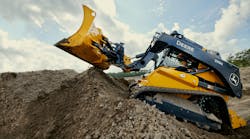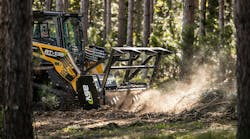The mountain pine beetle, dendroctonus ponderosae, is native to the forests of western North America.
Mountain pine beetles, as those involved in forestry know, have been around for a long time but haven’t devastated forests the way they have in recent years.
Taiga Earthworks Corp. uses an ASV RC-100 compact track loader with a Davco QC 1400 feller-buncher to removed trees attacked by mountain pine beetles in an effort to reduce the impact of the beetle infestation.According to Colorado State University researchers, mountain pine beetles – as their name suggests – develop in pines, most commonly ponderosa, lodgepole, scotch and limber pine. Bristlecone and pinon pine are less commonly attacked. During early stages of an outbreak, attacks are limited chiefly to trees under stress from injury, poor site conditions, fire damage, overcrowding, root disease or old age. However, as beetle populations increase, mountain pine beetle attacks may consume almost all large trees in the infested area. Colorado is expecting to lose 90 percent of its lodgepole pines in the next five years.
Why are mountain pine beetles rampant now? The answer: lack of extreme natural conditions.
Mountain pine beetles produce larvae that hatch beneath the bark, inside the trees. After the larvae hatch they destroy the inside of the tree by feeding off its nutrients. The tree then dies within a year, but the larvae live, producing more larvae in the next unsuspecting tree. In the past, winters were cold enough north of 35 degrees north latitude to control the pine beetle reproduction process. Temperatures must stay below 40 degrees from late fall through early spring to hurt the growing population of mountain pine beetles. And average temperatures have been inching up.
Adding to the problem, the number of natural burning forest fires has dropped. Forest fires, while devastating on their own, would kill pockets of pine beetle populations. As forest fires are controlled more quickly and summer temperatures leak into winter, today’s mountain pine beetles are living longer than their ancestors.
"Now that winter has hidden behind the summer months, you can see the patches of destruction," said Bob Houston of Taiga Earthworks Corp. "We are seeing more damage due to pine beetles."
Houston, owner and operator of Taiga Earthworks Corp., Alberta, Canada, has seen what the pine beetle can do. "They [mountain pine beetles] have migrated over the Rocky Mountains from British Columbia and infested the pine forest regions in Alberta."
In response to the growing number of mountain pine beetles, South Peace Municipalities (SPM) in Alberta was formed to control the impact of the infestation in an attempt to lessen the effects on forests. The overall goal of the program was to contain the progress of the pine beetle and limit its eastbound sprawl. SPM has been proactive in hiring companies such as Taiga Earthworks to control the growing beetle population.
Under contract from SPM, Taiga Earthworks Corp. is to cut, remove and dispose infested trees.
Pine beetles turn a tree’s needles from green to red to gray, and ultimately the dies. Houston’s company picks up the destruction. "There aren’t many people around here doing it," Houston said. "We are able to because we can go anywhere with our machine."
Taiga uses an ASV RC-100 compact track loader with a Davco QC 1400 feller-buncher. "It is ideally suited for this type of selective logging," said Houston. The buncher is an attachment paired with the ASV and used to cut and lift large timber from tight areas. Designed from the tracks up to operate in rugged terrain and exert minimal ground pressure, the RC-100 only applies 3.1 psi to the ground floor. It’s a unique machine that prevents further damage to trees in an already distressed area.
The dying trees lurk in national forests and on private properties. Surveyors find the infested trees, tie them with pink tape and mark them on GPS. "We get in there and selectively cut infested trees without harming adjacent trees or tearing up property; we basically have a rugged machine that doesn’t leave a footprint," Houston says of his RC-100.
It isn’t just property owners and public forests that are left with toothpicks. Toothpick makers, paper companies, hunters and local economies are affected by the mountain pine beetle. Experts say that 80 percent of mature trees in British Columbia will be infected by 2013. The pine beetle’s migration has been slowed by companies such as Houston’s, but they remain a forest predator.




